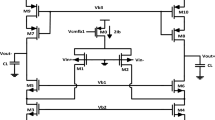Abstract
A fully integrated, low-power, low-noise OTA for Biosensor is proposed in this paper to detect biomedical signal using Implantable Health Devices. The proposed Operational Transconductance Amplifier is built basedon differential mirror circuit. The existing IMD detects a single disorder and consumes high power resulting in need of replacement within a period of time. The output of the proposed OTA is validated under a balanced low supply voltage by means of simulation results using 180 nm, 90 nm and 45nmCMOS technology. The proposed OTA absorbs power within the range of nano watts. Comparison with the designs mentioned in the article is based on gain, noise, location, transconductance, and bandwidth. The findings indicate substantial performance and improvement of the proposed OTA is related to previously published designs that are suitable for biomedical applications. The post layout simulation of the proposed integrated circuit was successfully performed.






















Similar content being viewed by others
References
Duarte D, Silva Cunha JP (2018) Wearable health devices—vital sign monitoring, systems and technologies. Sensors (MDPI, Switzerland) 1
Sattler L, Roger Glassily C, Saeed BI (1997) Benchmarking semiconductor manufacturing performance using a pairwise-comparison method. IEEE Trans Semiconduct Manuf 10:317
Darwish A, Hassanien AE (2011) Wearable and implantable wireless sensor network solutions for healthcare monitoring. Sensors (MDPI, Switz) 11:5561
Liang T, Yuan YJ (2016) Wearable medical monitoring system based on wireless networks: a review. IEEE Sensors J 6(23):8186–8199
Gorenek B, Boriani G, Dan G-A, Fauchier L, et-al. (2018) European Heart Rhythm Association (EHRA) position paper on arrhythmia management and device therapies in endocrine disorders, endorsed by Asia Pacific Heart Rhythm Society (APHRS) and Latin American Heart Rhythm Society (LAHRS). European Society of Cardiology, 1–30. https://doi.org/10.1093/europace/euy051
Limousin P, Krack P, Pollack P, Benazzouz A, Ardouin C, Hoffmann D, Benabid A (1998) Electrical stimulation of the sub thalamic nucleus in advanced Parkinson’s disease. N Engl J Med 339:1105–1111. https://doi.org/10.1056/NEJM199810153391603
Zhibin Xiao, Xi Tan, Xianliang Chen, Sizheng Chen, Zijian Zhang, Hualei Zhang, Junyu Wang, Yue Huang, Peng Zhang, LirongZheng, and Hao Min, “An Implantable RFID Sensor Tag toward Continuous Glucose Monitoring”, IEEE Journal Of Biomedical And Health Informatics, Vol. 19, No. 3, Pp: 910–919, May 2015.DOI: https://doi.org/10.1109/JBHI.2015.2415836.
Psychalinos C, Minaei S, Safari L (2020) Ultra low-power electronically tunable current-mode instrumentation amplifier for biomedical applications. Int J Electron Commun (AEÜ) 117:153120
Zamani M, Rezaeiyan Y, Shoaei O, Serdijn WA (2018) A 1.55 μW bio-impedance measurement system for implantable cardiac pacemakers in 0.18 μm CMOS. IEEE Trans Biomed Circuits Syst 12(1):211–221. https://doi.org/10.1109/TBCAS.2017.2776528
Sun-Il C, Euisik Y (2009) A 1μW 85nV/√Hz Pseudo open-loop preamplifier with programmable band-pass filter for neural interface system. IEEE Conference, pp: 1–4, 2009.978–1–4244–3296–7/09/
Li H, Parsnejad S, Ashoori E, Thompson C, Purcell EK, Mason AJ (2018) Ultracompact microwatt CMOS current readout with picoampere noise and kilohertz bandwidth for biosensor arrays. IEEE Trans Biomed Circuits Syst 12:35
Harrisonand RR, Charles C (2003) A low-power low-noise CMOS amplifier for neural recording applications. IEEE J Solid-State Circuits 38(6):958–965. https://doi.org/10.1109/JSSC.2003.811979
Derafshi ZH, Frounchi J (2014) Low-noise low-power front-end logarithmic amplifier for neural recording system. Int J Circuit Theory Appl 42:437–451. https://doi.org/10.1002/cta.1861
Dwivedi S, Gogoi AK (2015) Local field potential measurement with low-power area-efficient neural recording amplifier. IEEE Conference, 1–5. 978–1–4799–1823–2
ChengliangQian JordiParramon, Sánchez-Sinencio E (2011) A micropower low-noise neural recording front-end circuit for epileptic seizure detection. IEEE J Solid-State Circuits 46(6):1392–1405. https://doi.org/10.1109/JSSC.2011.2126370
Saidulu B, Manoharan A, Sundaram K (2016) Low noise low power CMOS telescopic-OTA for bio-medical applications. MDPI 5(25):1–11. https://doi.org/10.3390/computers5040025
Kakkar V, Ahmed S, Koul S (2015) An enhanced pre-amplifier for cochlear implants. ACTA TechnicaNapocensis Electron Telecommun 56(4):13–17
https://www.ikbooks.com/home/samplechapter?filename=125_Sample_Chapter/ Biosenor Components and Performance Factors
Ahmed JV, Rushworth NA (2014) Hirst, and Paul A. Millner Biosensors for whole-cell bacterial detection. Clin Microbiol Rev. https://doi.org/10.1128/CMR.00120-13
Mairaj S, Ahmed S, Kakkar VA (2018) A survey on emerging technologies and architectures of low power preamplifiers for biomedical applications. Int J Nanoelectron Mater 11(2):167–178
Molleman A (2003) Patch clamping: an introductory guide to patch clamp electrophysiology. Wiley, Hoboken
Purcell EK et al (2013) BDNF profoundly and specifically increases KCNQ4 expression in neurons derived from embryonic stem cells. Stem Cell Res 10:29–35
Venkatesh M, Balamurugan NB (2020) Influence of threshold voltage performance analysis on dual halo gate stacked triple material dual gate TFET for ultra low power applications. SILICON 13:275–287
Gifta G, Rani DGN, Farhana N, Archan R (2019) Design of CMOS based biosensor for implantable medical devices. Springer Nature Singapore, VDAT 2018, CCIS 892, pp 695–704. https://doi.org/10.1007/978-981-13-5950-7_57
Lee J, Lee K-R, Ha U, Kim J-H, Lee K, Gweon S, Jang J, Yoo H-J (2019) A 0.8-V 8.29-μW in-ear BCI controller IC with 8.8 PEF EEG instrumentation amplifier and wireless BAN transceivers. IEEE J Solid-State Circuits. https://doi.org/10.1109/JSSC.2018.2888845
Chen C, Chen L, Wang X, Zhang F (2018) A 0.6V, 8.4 uW AFE circuit for biomedical signal recording. Microelectron J 75:105–112
Krishna JR, Laxminidhi T (2019) Widely tunable low-pass gm−C filter for biomedical applications. IET Circuits Devices Syst 13:239–244
Hsu Y-P, Liu Z, Mostafa Hella M (2020) ‘A 68 dB THD, 0.6 mm 2 active area biosignal acquisition system with a 40–320 Hz duty-cycle controlled filter. IEEE Trans Circuits Syst Ii: Express Briefs. https://doi.org/10.1109/TCSI.2019.2943904
Luo D, Zhang M, Wang Z (2019) A low-noise chopper amplifier designed for multi-channel neural signal acquisition. IEEE J Solid-State Circuits 54(8):2255–2265. https://doi.org/10.1109/JSSC.2019.2913101
Chandrasekaran G, Periyasamy S, Panjappagounder Rajamanickam K (2019) Test scheduling for system on chip using modified firefly and modified ABC algorithms. SN Appl Sci 1(9):1079. https://doi.org/10.1007/s42452-019-1116-x/
Chandrasekaran G, Periyasamy S, Panjappagounder Rajamanickam K (2020) Minimization of test time in system on chip using artificial intelligence-based test scheduling techniques. Neural Comput Appl 32:5303–5312. https://doi.org/10.1007/s00521-019-04039-
Author information
Authors and Affiliations
Corresponding author
Additional information
Publisher's Note
Springer Nature remains neutral with regard to jurisdictional claims in published maps and institutional affiliations.
Rights and permissions
About this article
Cite this article
Gifta, G., Rani, G.N. & Rajaram, S. Design of Low Noise, Low Power, Bulk-Driven CMOS Based Operational Transconductance Amplifier for Biosensor Applications. J. Electr. Eng. Technol. 16, 2793–2807 (2021). https://doi.org/10.1007/s42835-021-00770-0
Received:
Revised:
Accepted:
Published:
Issue Date:
DOI: https://doi.org/10.1007/s42835-021-00770-0




